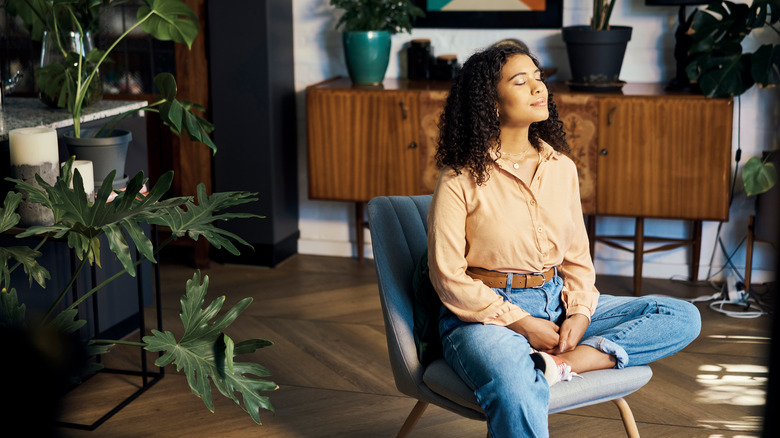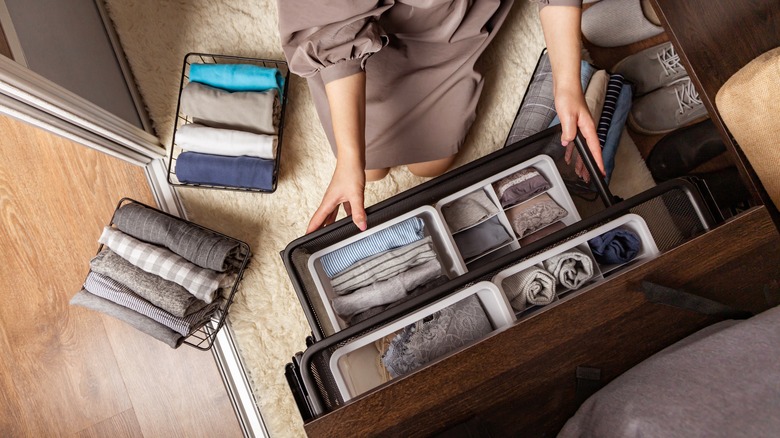What To Know Before Starting Marie Kondo's KonMari Organizing Method
Have you ever looked around your living space and felt overwhelmed by the sheer amount of stuff surrounding you? Many people long for a more organized and joyful living environment. That's where the KonMari Method comes in. Developed by the renowned Japanese organizing consultant Marie Kondo, this method has gained worldwide popularity for its transformative approach to decluttering and organizing. It's not only effective but draws attention to mindfulness and introspection. People embark on the KonMari journey for various reasons. Some strive for order amid chaos, while others prefer a simpler life with only what matters.
The KonMari Method is more than just tidying up. It's about creating a space that ignites happiness and aligns with your ideal lifestyle. You keep items that bring you joy and discard the rest for a profound shift in your physical surroundings and well-being. Before diving in, it's essential to learn all you can about the method to set yourself up for success. Understanding the core principles and categories allows for a systematic approach, saving time and energy. Learning about the emotional aspects prepares you for attachment and resistance to change. Finally, by educating yourself beforehand, you empower yourself with the knowledge and tools to embark on this decluttering journey. Here are some essential things to know about the KonMari Method.
You need to begin with a mindset shift
The KonMari Method places a strong emphasis on the importance of approaching the decluttering process with a positive mindset and a grateful attitude. Kondo believes that cultivating these qualities is essential before diving into tidying. Rather than seeing it as an overwhelming task you don't want to do, shift your thinking. Rather than it being tedious, frame it as an exciting opportunity to take control and change your life.
By adopting a positive mindset, you open yourself up to the potential for change and personal growth. This mindset allows you to recognize the value of your belongings and appreciate their role in your life. This process improves the decluttering experience and provides insight into your own preferences and priorities. It can also make the process more enjoyable and uplifting. Therefore, before embarking on the KonMari Method, taking the time to set a positive intention will empower you to create a living environment that sparks joy in every aspect.
You need to commit to the process
The KonMari Method is not a quick fix or a superficial organizing technique. It is a comprehensive approach to tidying that demands commitment and dedication. If you're considering embarking on this journey, it's crucial to understand that the KonMari Method is not something you can complete haphazardly or in a rush. It requires sufficient time and effort to thoroughly review each category. Set aside dedicated blocks of time to ensure you can devote your full attention to the process. Doing so creates a space for deep introspection and thoughtful decision-making. Avoid rushing through the process or skipping categories to save time.
It's important to approach the KonMari Method with patience and kindness toward yourself. During the process, you may encounter sentimental items or face tough decisions about letting go of certain belongings. It's natural to experience moments of uncertainty or emotional attachment. Be gentle with yourself, and do not beat yourself up over these moments. The decluttering journey can be a roller coaster, but the key is to stay committed and keep the end goal in mind. Remember, the KonMari Method is not about perfection or achieving a perfectly organized space overnight. Each step forward, no matter how small, brings you closer to your goal of a clutter-free and joy-filled home.
You should learn the categories first
One of the defining features of the KonMari Method is its unique approach to decluttering by category rather than by room. This method organizes possessions into five main categories: clothes, books, papers, miscellaneous (also known as komono), and sentimental items. The clothes category includes more than just your closet. You'll gather every clothing item you own, including coats, accessories, and off-season garments, and place them in one big pile. This allows you to see everything together and decide about each piece individually, based on the principle of joy. When it comes to books, you'll address the shelves and stacks of titles that have accumulated over time. This category is pretty self-explanatory, but it's important to go through each book in your collection.
The paper category includes documents, bills, letters, and other paper-related items. This section often requires careful sorting and organizing to eliminate unnecessary clutter and create a system that works for you. The miscellaneous category encompasses a wide range of items found in various areas of your home, such as kitchenware, electronics, and household supplies. It's best to break these down into smaller categories to avoid getting overwhelmed. Sentimental items are addressed last since they often carry strong emotional attachments. By the time you reach this section, you'll have honed your decision-making skills, making it easier to determine what to keep. Understanding the categories in the KonMari Method is crucial because it allows you to see the act of organizing in a bigger picture.
You need to know that it's a holistic approach
The KonMari Method is more than just a simple approach to decluttering and organizing. It's a holistic process that takes into account the interconnectedness of our physical space, emotional well-being, and personal growth. When we refer to a holistic approach, we mean considering the whole picture and understanding that our surroundings have a profound impact on our overall quality of life. Living in an organized and decluttered home boosts many positive benefits, including increased productivity, improved sleep, more time, and less stress.
Kondo's process goes beyond surface-level tidying. It encourages you to assess the emotional and psychological impact items have on you. This means considering how each possession aligns with your values, supports your desired lifestyle, and brings you joy. As we cultivate a harmonious living environment, we often find ourselves experiencing a greater sense of clarity, focus, and peace of mind. We can direct our energy toward more important pursuits, nurture relationships better, and engage in thoughtful self-care.
You'll want to visualize your ideal lifestyle
Before you dive headfirst into the exciting adventure of decluttering, take a moment to pause and visualize your ideal lifestyle. Picture the environment you want to create — a space that reflects your values, supports your goals, and brings you joy and calm. This visualization exercise is a powerful tool that can help you stay focused and motivated throughout your decluttering journey. By having a clear vision of your desired outcome, you create a roadmap that guides your decision-making process. So, how can you keep track of your ideal lifestyle and ensure it remains at the forefront of your mind as you declutter?
One idea is to create a vision board. Gather images, quotes, and inspirations that represent your perfect living environment and arrange them on a board. Display it in a prominent place in your home as a visual reminder of your goals. Additionally, consider creating a Pinterest board or a digital folder if you don't want to collage. Another way is to create a written or digital journal. Use it to jot down your vision, specific goals, and the emotions you want your space to evoke. Write about the activities you hope to engage in, the ambiance you desire, and the overall atmosphere you want to create. Revisit your journal regularly, especially during challenging moments in the process, to reconnect with your aspirations and maintain your motivation.
You'll learn specific folding techniques
One of the most fascinating aspects of the KonMari Method is the art of folding. Kondo introduces specific folding techniques that go beyond simply organizing your clothes. They help maximize storage space and make every item more visible. The method introduces techniques such as the rectangular fold, which transform clothing items into compact rectangles that can be neatly stacked upright in drawers. This not only saves space but also allows you to see each item at a glance, avoiding the frustrating task of rummaging through piles of clothes.
The beauty of these folding techniques is that they can be adapted to various types of clothing, from T-shirts and pants to socks and undergarments. You can watch video tutorials about these folding techniques on Marie Kondo's website to get an idea of what you'll be doing. As you master these techniques, you'll not only appreciate the practical benefits of maximizing storage space but also discover the aesthetic pleasure of seeing your clothes neatly arranged. Opening your drawers or wardrobe and seeing a visual feast of neatly folded clothes can bring a sense of joy and serenity to your daily routine.
You'll want to stick to the sequence
Marie Kondo didn't just come up with the sequence randomly. She designed it for a reason, and it's crucial to follow it as she recommends. The sequence plays a significant role in improving your decision-making skills and making the entire decluttering process much easier for you. The KonMari Method, which starts with clothes, then moves on to books, papers, miscellaneous items, and sentimental items, is intentionally crafted. Each category builds upon the skills and mindset developed in the previous one. By following this order, you gradually hone your ability to discern what truly sparks joy and make decisions based on that principle.
For first-timers, sticking to the sequence is especially important. It allows you to build confidence and gain momentum as you progress through the categories. Starting with clothes, for instance, might seem relatively straightforward, as you're familiar with your wardrobe and can practice making decisions based on joy. It serves as a warm-up exercise for the more sentimental categories that come later. Following the sequence helps you to trust your instincts and develop a stronger sense of what truly brings happiness into your life. Resist the temptation to jump ahead or skip categories. Trust the process and embrace the wisdom of the sequence. When you do, you set yourself up for success, making the decluttering journey smoother and more rewarding.
Tell your family and get them involved
If you live with other people, it's important to remember that organization is a team effort. Taking the time to discuss the method and encouraging open communication about organizing goals can lead to a harmonious living environment that benefits everyone. Start by having a conversation with your family or housemates about your intention to embark on the KonMari journey. When discussing plans with family, be honest and explain the bigger picture of what decluttering will do for the household. By involving everyone, you create a sense of shared responsibility and foster a cooperative mindset toward decluttering and organizing.
One of the significant benefits of doing the KonMari Method together is that it strengthens the bond within the household. It becomes a collective project where everyone's opinions and feelings are valued. Through open communication, you can gain insights into each person's attachment to certain items, their organizational preferences, and their vision for an ideal living environment. This understanding creates a foundation for compromise, support, and mutual respect throughout the decluttering journey. When everyone participates in creating a space that sparks joy and reflects their values, it instills a sense of pride and ownership. It becomes a shared commitment to maintaining the tidiness and joyful atmosphere you've created together.








